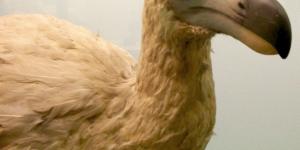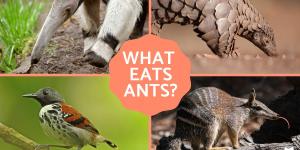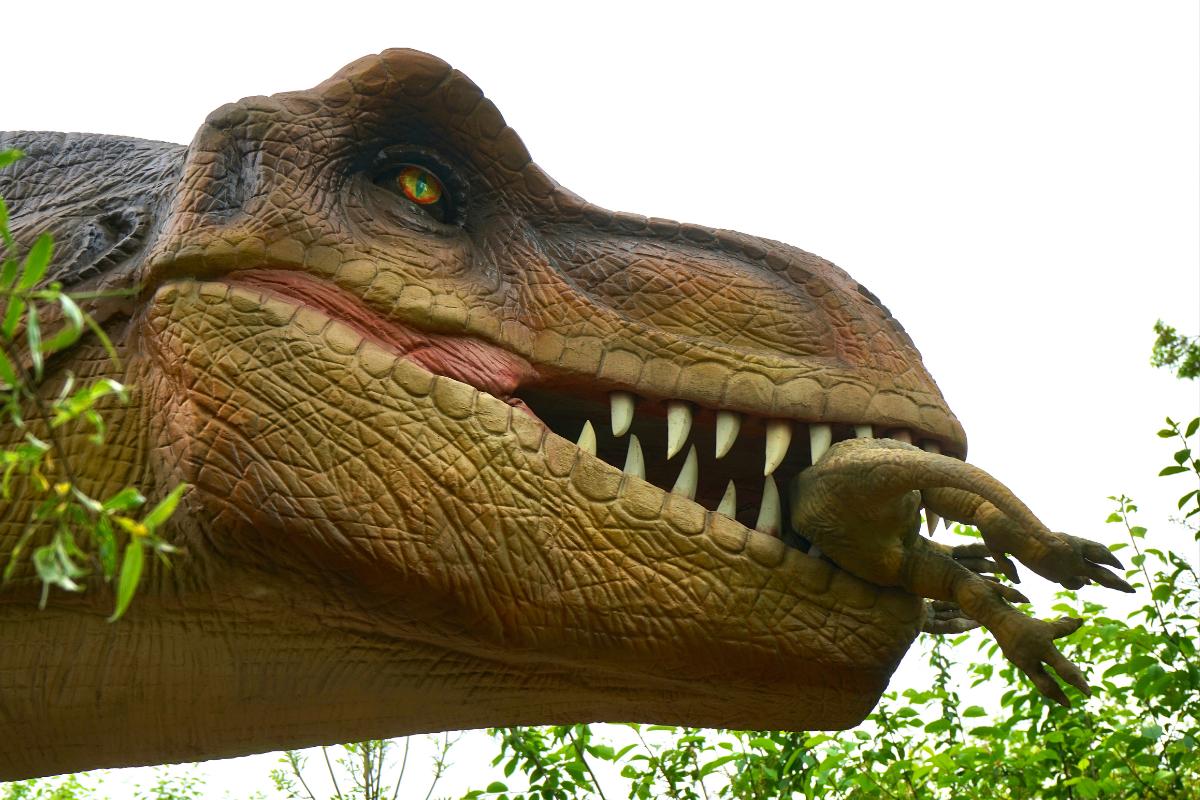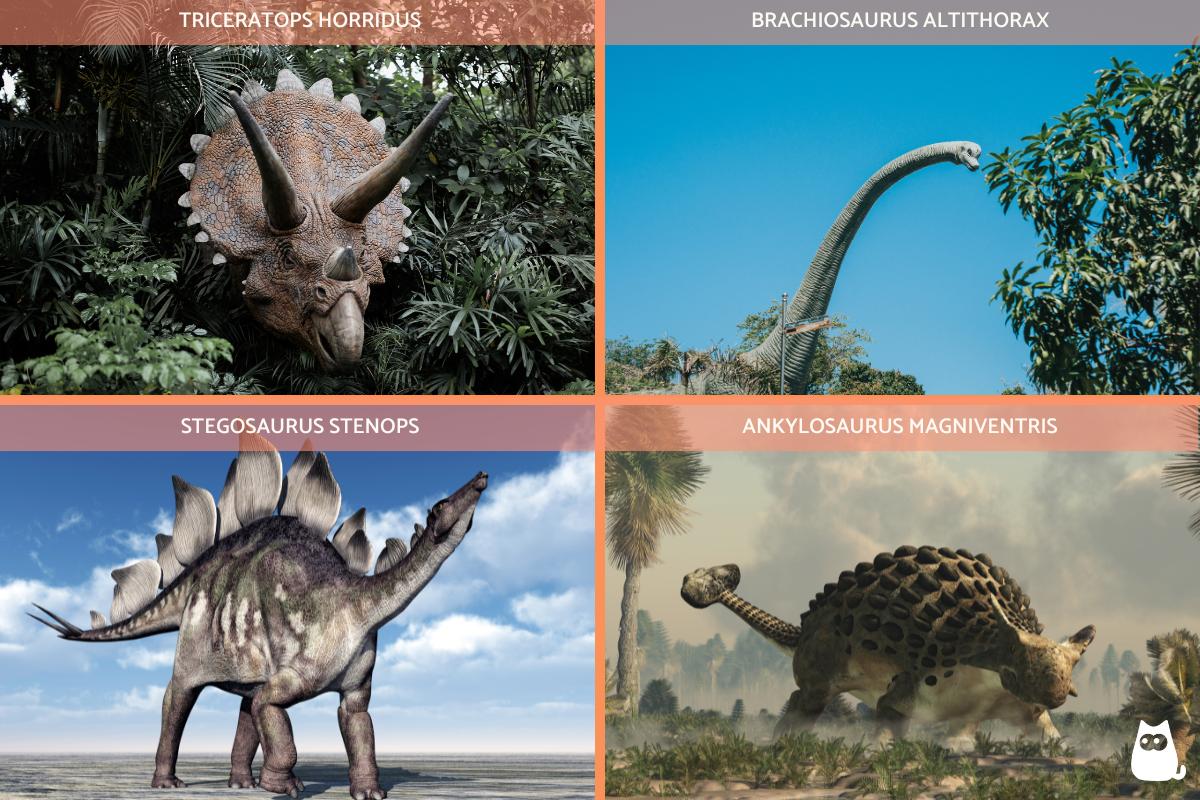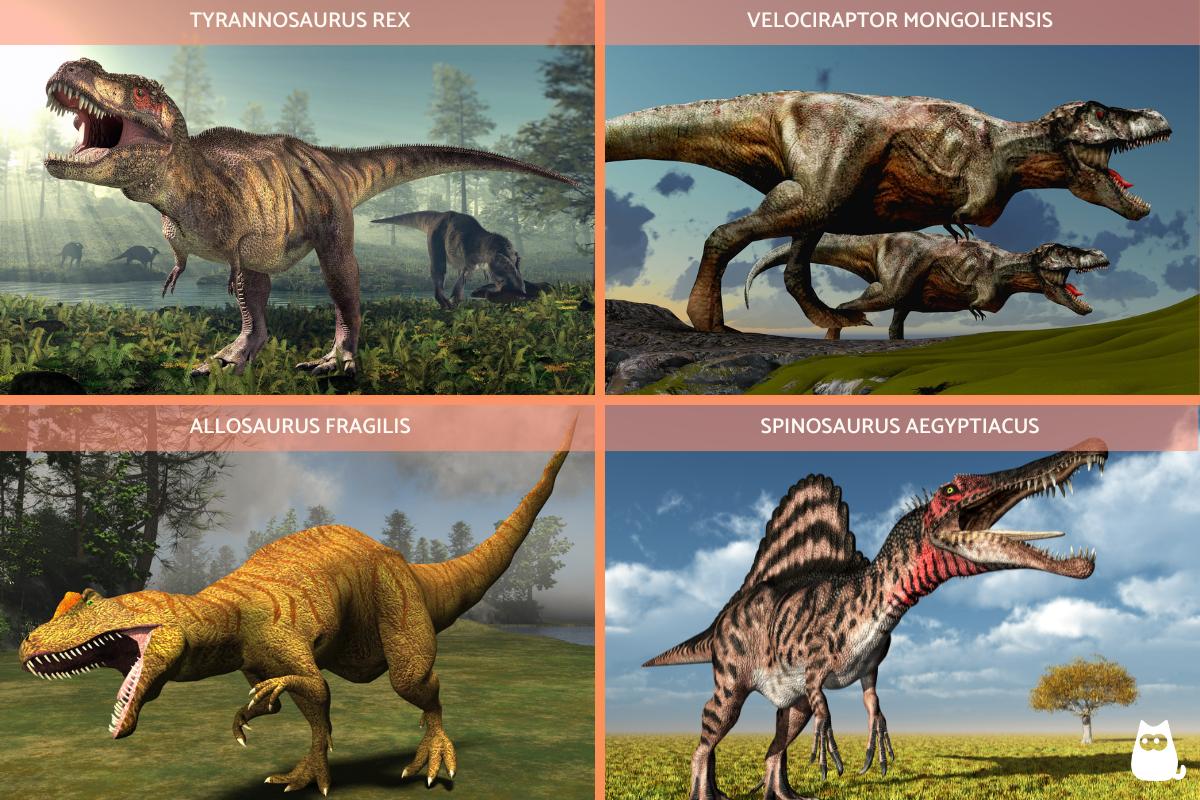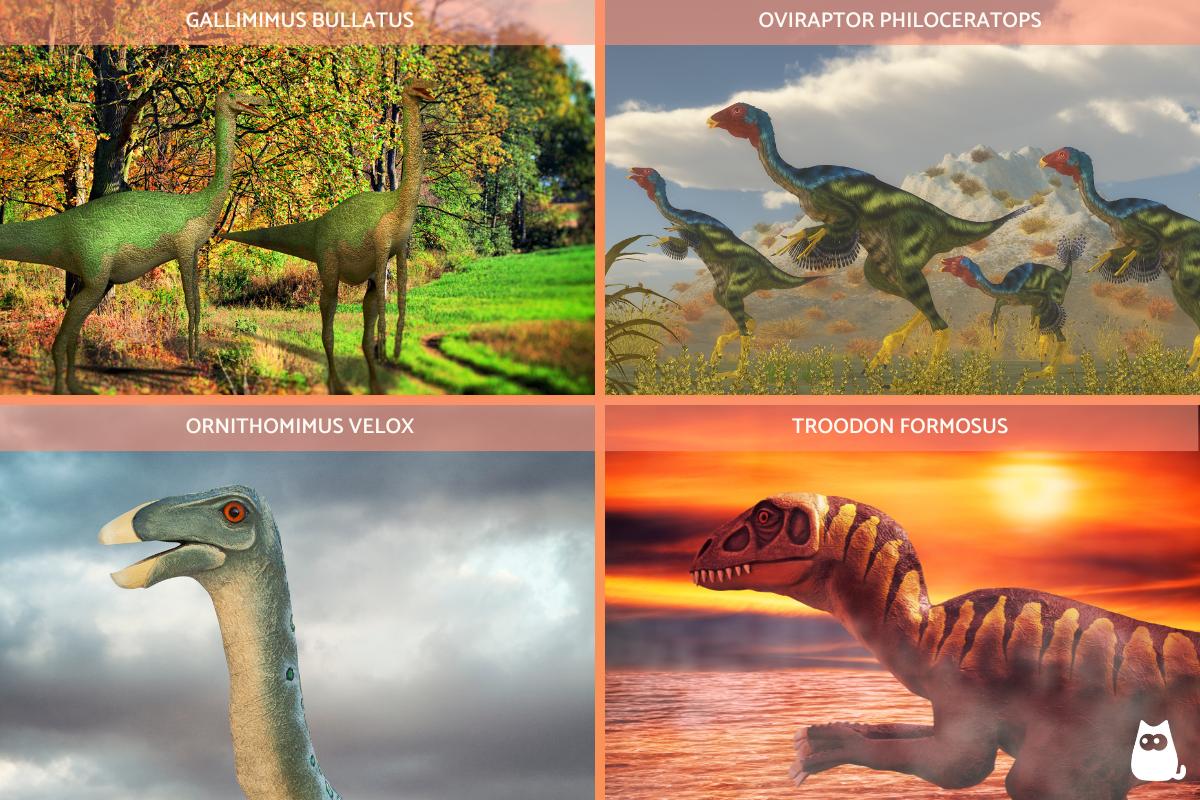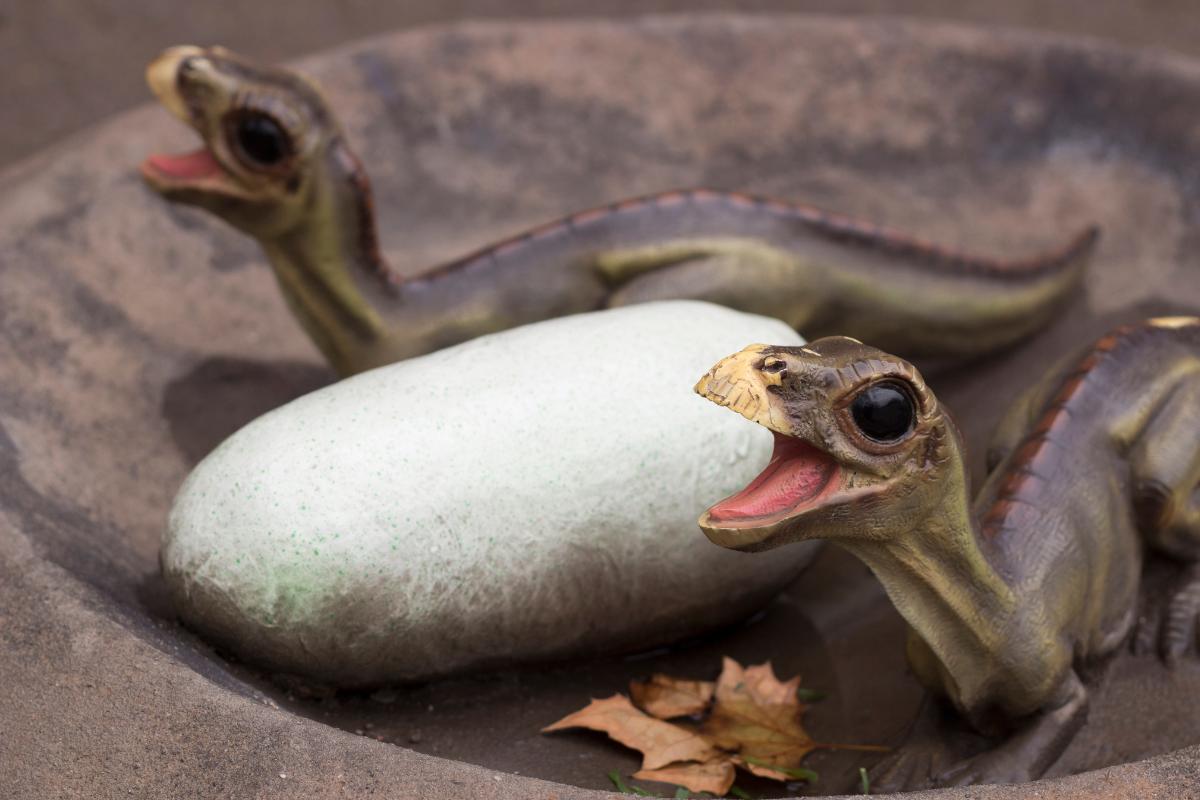What Did Dinosaurs Eat?

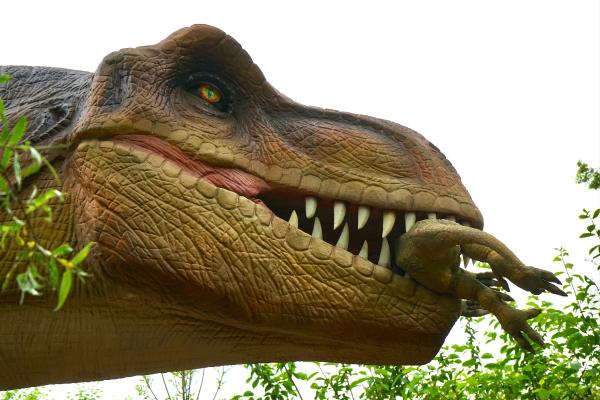
For 165 million years, dinosaurs reigned over Earth, and their diverse diets were pivotal in shaping their evolution, behavior, and ecological roles. From colossal herbivores that ate vast quantities of plants to formidable carnivores that preyed on other dinosaurs, their feeding habits dictated their lifestyles, locomotion, and interactions within their environments. Paleontologists have pieced together a detailed picture of dinosaur diets through a wealth of fossil evidence, including teeth, jaw structures, preserved stomach contents, and fossilized feces.
This AnimalWised article delves into the diets of dinosaurs, examining their varied eating habits and the evolutionary adaptations that arose from them.
What are the three types of dinosaur diets?
Dinosaurs dominated Earth for over 165 million years and developed diverse eating habits that shaped their evolution, behavior, and ecological roles. They evolved specialized feeding strategies that allowed different species to thrive alongside each other without directly competing for the same food resources. The three main dinosaur diets are:
- Herbivorous: plant-eating dinosaurs consumed a variety of prehistoric vegetation including ferns, cycads, conifers, ginkgoes, and horsetails. Most herbivores spent the majority of their time feeding to sustain their often massive bodies. Different species specialized in specific plant types and feeding heights, with some browsing on tall trees while others grazed on ground-level vegetation.
- Carnivorous: meat-eating dinosaurs primarily consumed other animals, including smaller dinosaurs, mammals, reptiles, and fish. Their diets varied by size and hunting ability. Most combined both hunting and scavenging depending on opportunity.
- Omnivorous: these dietary generalists ate a mixed diet of both plant material and animal matter. Their food choices often included seeds, fruits, eggs, insects, small vertebrates, and various plant parts. Omnivores could adjust their diets seasonally or based on food availability, giving them flexibility in changing environments.
This diversity of feeding strategies allowed different dinosaur species to coexist in the same ecosystems without direct competition for food resources, similar to how modern animals divide ecological niches.
Diet influenced every aspect of dinosaur biology, from their size and social behavior to their movement patterns and evolutionary adaptations. What dinosaurs ate determined how they lived - herbivores often moved in protective herds, while carnivores developed hunting strategies either as solitary predators or pack hunters. Some omnivores likely adjusted their social behaviors based on available food sources. These dietary patterns reveal crucial information about prehistoric ecosystems. They tell us which species competed for food, who ate whom, and how energy flowed through ancient food webs.
How do scientists know what dinosaurs eat?
Dinosaur diets are understood through both direct and indirect evidence. First, scientists study teeth and jaw shapes to identify feeding patterns. For example, sharp, serrated teeth signal meat-eating while flat, ridged teeth indicate plant consumption.
Additionally, fossilized droppings (coprolites) preserve undigested food remains, revealing exactly what passed through their digestive systems. In rare cases, fossilized stomach contents offer definitive proof of an animal's last meal.
Furthermore, chemical analysis of bones, particularly carbon isotope patterns, distinguishes between plant and meat consumption without visible food evidence. Finally, scientists also compare dinosaur feeding structures with modern relatives like birds and crocodilians to understand how these features functioned in life, thus completing our picture of prehistoric eating habits.
Herbivorous dinosaurs
Herbivorous dinosaurs had physical traits that helped them eat and digest plants. These plant-eaters typically formed the base of dinosaur food chains, converting plant energy into body mass that carnivorous dinosaurs could then consume.
Some of these adaptations include:
- Flat, ridged teeth for grinding tough plant material instead of cutting.
- Complex jaw structures that allowed side-to-side grinding motions.
- Specialized beaks in many species for efficiently stripping vegetation.
- Larger digestive systems to process fibrous plant matter that's harder to break down.
Most herbivorous dinosaurs faced the challenge of extracting nutrition from tough plants. Therefore, they developed several methods to process their food.
Many swallowed stones called gastroliths that collected in their gizzards to grind plant material. Their large digestive tracts likely contained bacteria that broke down cellulose through fermentation, similar to modern cows.
Different herbivores specialized in different feeding strategies. Sauropods like Brachiosaurus used their long necks to reach high vegetation other dinosaurs couldn't access. Low browsers like Stegosaurus focused on ferns and low-growing plants. Ceratopsians like Triceratops used their powerful beaks to slice through tougher vegetation.
Fossil evidence suggests many herbivorous dinosaurs lived in herds. Trackways show multiple individuals of the same species moving together. This social behavior likely provided protection from predators. Younger dinosaurs could stay in the center of the herd, while adults with defensive features like horns and spikes faced outward to deter attackers.
Examples of herbivorous dinosaurs:
- Triceratops horridus: this Late Cretaceous ceratopsian (68-66 million years ago) had a beak-like mouth for slicing through vegetation. Its three-horned face and large frill may have protected it while feeding on low-growing plants. Triceratops constantly replaced its teeth as they wore down from grinding plant material.
- Brachiosaurus altithorax: this Late Jurassic sauropod (154-153 million years ago) used its long neck to reach high into trees where other dinosaurs couldn't feed. Standing up to 40 feet tall, Brachiosaurus consumed hundreds of pounds of conifer branches, tree ferns, and ginkgo leaves daily.
- Stegosaurus stenops: with its small head and peg-like teeth, this Late Jurassic herbivore (155-150 million years ago) was a low-browsing herbivore that ate ferns, cycads, and other ground-level plants. Its narrow snout may have allowed it to select the most nutritious parts of plants.
- Ankylosaurus magniventris: this armored dinosaur from the Late Cretaceous (68-66 million years ago) had a wide snout for browsing low-growing vegetation. Its small, leaf-shaped teeth were designed for stripping leaves from branches rather than chewing. Ankylosaurus likely processed most food in its large gut through fermentation.
Did you know that some herbivorous dinosaurs processed over a ton of plant material daily? Learn about these and other amazing plant-eaters in our other article.
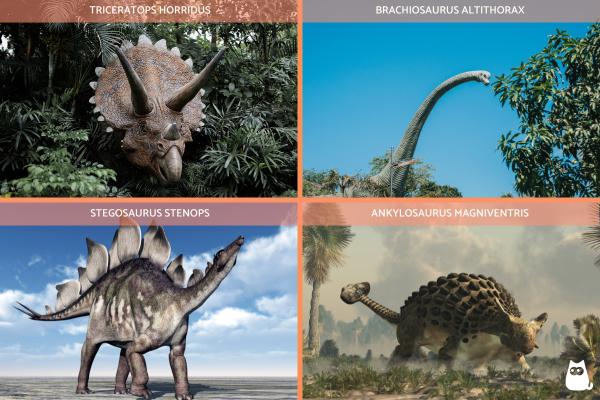
Carnivorous dinosaurs
Carnivorous dinosaurs were meat-eating dinosaurs that evolved specific adaptations for hunting, killing, and consuming animal prey. These meat-eaters typically occupied the top positions in dinosaur food chains, controlling herbivore populations through predation.
Some of these adaptations include:
- Sharp and serrated teeth to cut through flesh and bone.
- Strong jaw muscles that allowed them to bite with great force.
- Sharp claws in their front limbs often had for grabbing and holding prey. Many had keen eyesight with forward-facing eyes for better depth perception while hunting.
- Lightweight and hollow bones that made them fast and agile.
Most large carnivorous dinosaurs likely did both hunting and scavenging. Fresh kills provided the most nutrition, but passing up free meals would waste energy. For example, T. rex bite marks on fossils show it ate already-dead dinosaurs. But its speed and sensory abilities suggest it could hunt live prey too.
Smaller carnivores probably relied more on active hunting, since they could be driven away from carcasses by larger competitors.
Fossil trackways show some carnivorous dinosaurs moved in groups. Multiple sets of footprints from the same species heading in the same direction suggest pack behavior. Bite marks from different-sized members of the same species on prey bones also suggest group attacks, where individuals of different ages worked together to bring down large herbivores. Pack hunting would have let smaller carnivores take down prey much larger than themselves, similar to how wolves hunt today.
Examples of carnivorous dinosaurs:
- Tyrannosaurus rex: this Late Cretaceous theropod (68-66 million years ago) had bone-crushing teeth and powerful jaws that could deliver one of the strongest bites in land animal history. T. rex likely hunted large herbivores but also scavenged when opportunities arose, using its keen sense of smell to locate carcasses.
- Velociraptor mongoliensis: this Late Cretaceous dromaeosaur (75-71 million years ago) was a turkey-sized predator with a sickle-shaped claw on each foot for slashing prey. Fossil evidence suggests it hunted in packs and may have targeted prey much larger than itself, including plant-eating dinosaurs.
- Allosaurus fragilis: this Late Jurassic predator (155-145 million years ago) was the dominant carnivore of its time. With serrated teeth and strong forearms with three-fingered claws, Allosaurus likely ambushed prey and used repeated slashing bites to bring down larger herbivores.
- Spinosaurus aegyptiacus: this Mid-Cretaceous theropod (112-97 million years ago) was possibly the largest carnivorous dinosaur. With its crocodile-like snout and conical teeth, Spinosaurus primarily hunted fish and other aquatic prey in its semi-aquatic habitat, though it likely ate land animals as well.
Curious about the apex predators of the prehistoric world? Explore our countdown of the most fearsome meat-eaters that ever stalked the Earth.
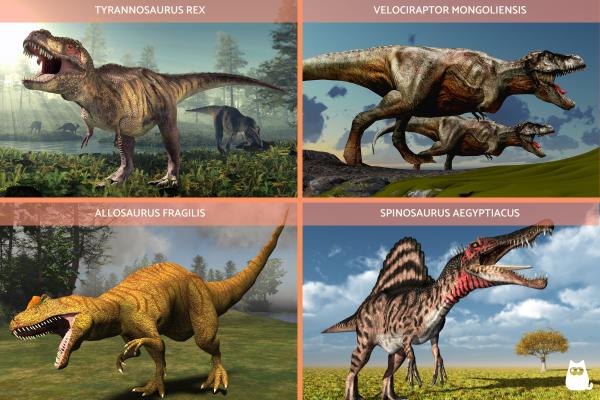
Omnivorous dinosaurs
Omnivorous dinosaurs were adaptable eaters that consumed both plant material and animal prey. These meat-eaters typically occupied the top positions in dinosaur food chains, controlling herbivore populations through predation.
Some of these adaptations include:
- Versatile teeth with different shapes in different parts of the jaw for various food types.
- Moderately strong jaw muscles that could handle both plant material and smaller prey.
- Flexible digestive systems capable of processing both animal protein and plant fiber.
- Generalized limb structures with some grasping ability while maintaining mobility.
Most omnivorous dinosaurs benefited from dietary flexibility. This means that they could switch food sources depending on what was available seasonally or geographically. This adaptation helped them survive in changing environments. For example, Gallimimus had a toothless beak for plants but could also chase and catch small animals.
Different omnivores specialized in different feeding proportions. Some ate primarily plants with occasional meat, while others preferred meat but supplemented with plant matter. Oviraptor, once thought to be an egg thief, likely ate a mix of eggs, small animals, seeds, nuts, and fruits.
Fossil evidence suggests omnivorous dinosaurs used various feeding strategies. Tooth marks and stomach contents show diverse diets. Their versatile eating habits gave them advantages during food shortages when specialized eaters might struggle. This dietary flexibility is similar to modern bears and raccoons, which eat whatever food sources are available in their environment.
Omnivorous dinosaurs filled middle positions in prehistoric food webs, sometimes competing with both herbivores and carnivores depending on what they were eating at the time. This dietary flexibility represents an important evolutionary strategy that continues to be successful among many modern animals.
Examples of omnivorous dinosaurs:
- Gallimimus bullatus: this Late Cretaceous ornithomimid (70-68 million years ago) had a toothless beak similar to modern birds. Its diet likely included plants, insects, small animals, and eggs. Its long legs made it one of the fastest dinosaurs, helping it catch small prey while also allowing it to cover large areas when foraging for plant food.
- Oviraptor philoceratops: this Late Cretaceous theropod (75-71 million years ago) was once thought to be an egg thief, but likely had a varied diet. Its strong, toothless beak could crush hard foods like seeds and nuts, while also handling meat, eggs, and fruits. Fossil evidence shows it nested on eggs like modern birds.
- Ornithomimus velox: this Late Cretaceous dinosaur (76-66 million years ago) had a bird-like head with a toothless beak. Studies of its jaw mechanics and diet-related adaptations suggest it ate both plants and small animals. Its hand structure allowed it to grasp food items of various types.
- Troodon formosus: this Late Cretaceous troodontid (77-76 million years ago) had serrated teeth suited for a mixed diet. With some of the largest brain-to-body size ratios among dinosaurs, Troodon likely used its intelligence to exploit various food sources including plants, eggs, insects, and small vertebrates depending on availability.
While dinosaurs were evolving diverse eating strategies on land, equally impressive reptiles were adapting to life in ancient oceans.
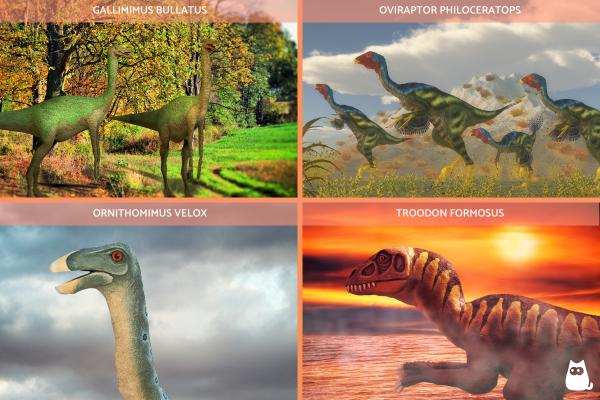
What did baby dinosaurs eat?
Baby dinosaurs likely had different diets from adults in many species. Their smaller size, developing digestive systems, and growth needs created unique dietary requirements during early life stages.
Young carnivorous dinosaurs probably couldn't hunt large prey like adults. Fossil evidence suggests they targeted smaller animals like insects, lizards, and small mammals that were easier to catch and eat. Their developing jaw strength and smaller teeth made tackling large prey impossible until they grew larger.
For herbivorous dinosaurs, young individuals likely focused on softer, more nutritious plants than the tough vegetation adults consumed. Their smaller bodies couldn't process the same volume or toughness of plant material. Some may have targeted specific nutrient-rich parts of plants like new growth, fruits, or seeds.
Parental feeding played an important role for many species. Evidence from nesting sites shows adult dinosaurs bringing food to nests for their young. In carnivorous species, parents might have returned with partially digested meat or smaller prey items. Herbivore parents possibly gathered softer vegetation for their offspring.
Some dinosaur groups may have practiced regurgitation feeding like many modern birds. Adults would partially digest food and then regurgitate it for their young, making nutrients more accessible. This behavior would leave minimal fossil evidence but fits with the bird-dinosaur evolutionary connection.
As young dinosaurs grew, they gradually transitioned to adult diets. Tooth replacement patterns in fossils show changes in tooth shape and size during growth, reflecting shifts in diet as dinosaurs matured. This dietary transition aligned with overall body changes as dinosaurs developed toward adulthood.
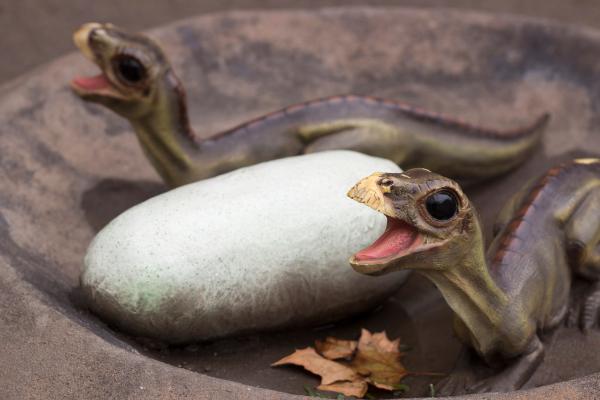
If you want to read similar articles to What Did Dinosaurs Eat?, we recommend you visit our Facts about the animal kingdom category.
- Barrett, P. M. (n.d.). Diet: Herbivores. Natural History Museum. Retrieved March 18, 2025, from https://www.nhm.ac.uk/discover/dino-directory/diet/herbivores/gallery.html
- Butler, R. (2022, December 15). The diet of the first dinosaurs. University of Bristol. https://www.bristol.ac.uk/news/2022/december/diet-of-first-dinosaurs.html
- Melville, K. (n.d.). The dynamic diet of dinosaurs. Science World. Retrieved March 18, 2025, from https://www.scienceworld.ca/stories/the-dynamic-diet-of-dinosaurs/
- Montanari, S. (2022, December 5). Dinosaur diets may help explain dramatic diversity. Scientific American. https://www.scientificamerican.com/article/dinosaur-diets-may-help-explain-dramatic-diversity/
- Ramdarshan, A., Bertin, T. J. C., Ősi, A., Goussard, F., Lasseron, M., Glynn, C., Lauters, P., Verrière, A., Clauss, M., Schwarz, D., & Lautenschlager, S. (2023). Dietary ecology of non-avian dinosaurs. Biological Reviews of the Cambridge Philosophical Society, 98(1), 202-222. https://pubmed.ncbi.nlm.nih.gov/36525501/


